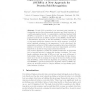192 search results - page 10 / 39 » A dimensionality reduction approach to modeling protein flex... |
118
click to vote
RECOMB
2005
Springer
15 years 11 months ago
2005
Springer
Abstract. Protein fold recognition is an important step towards understanding protein three-dimensional structures and their functions. A conditional graphical model, i.e. segmenta...
IJCNN
2000
IEEE
15 years 3 months ago
2000
IEEE
: The main purpose of this work is to create a physiologically realistic computational model of the retina by providing a flexible, real-valued three-dimensional architecture. This...
102
click to vote
KES
2006
Springer
14 years 11 months ago
2006
Springer
In this paper, in order to reduce the explosive increase of the search space as the input dimension grows, we present a new representation method for the structure of fuzzy rules, ...
101
click to vote
JMLR
2010
14 years 6 months ago
2010
We develop a Bayesian framework for supervised dimension reduction using a flexible nonparametric Bayesian mixture modeling approach. Our method retrieves the dimension reduction ...
ICCAD
2006
IEEE
15 years 8 months ago
2006
IEEE
Process variations in modern VLSI technologies are growing in both magnitude and dimensionality. To assess performance variability, complex simulation and performance models param...

